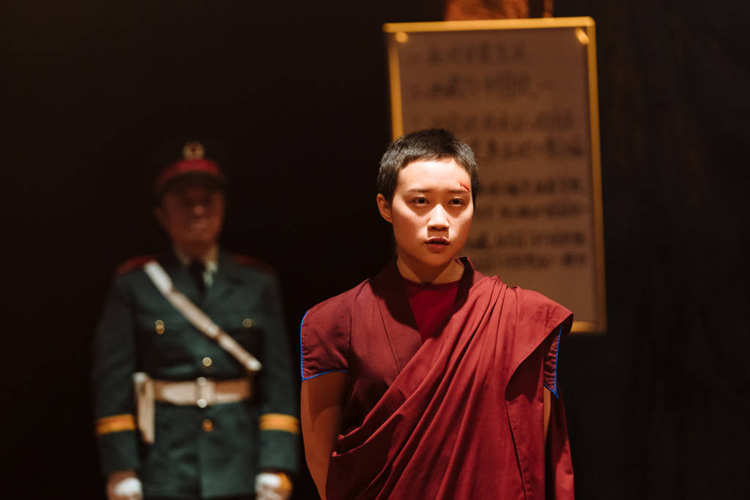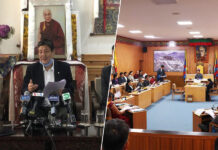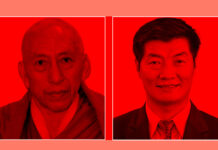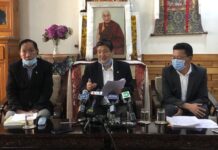Pah-La written by Abhishek Majumdar
Directed by Debbie Hannan
Royal Court Theatre, London, UK
Reviewed by Georgina Choekyi Doji, Tenzing Zega, Dechen Pemba, Kunsang Kelden, and Sonam Anjatsang*
(TibetanReview.net, Apr18’19)
Much has been made of the five years of research, including journeys to China and Tibet, and “countless” interviews with Chinese and Tibetan individuals, which went into the creation of Pah-La, Abhishek Majumdar’s play set against the backdrop of the 2008 Lhasa protests. The acknowledgements in the playtext are extensive, detailing sometimes explicitly and sometimes, necessarily, obliquely the work undertaken to bring the piece to life. It is a great shame that little evidence of this research seems to have found its way into the final piece.
There are significant problems with the play. As for the story, it follows Deshar, a young Buddhist nun, who self-immolates and in doing so, sparks a wave of violent protests. The first act takes place in a nunnery in eastern Tibet, in which the Chinese Commander Deng leads soldiers to put the nuns through a process of “re-education” and ultimately destroy the nunnery itself in order to build a hospital; the second takes place in Lhasa, where Deshar has been brought for interrogation, and Tibetans are using her as inspiration for their own violence against Chinese authorities, in the form of attacks on non-Tibetan people and property. It is in this second act where the most significant problems lie.
Creating works of historical fiction carries a particular challenge: how to present the past honestly, whilst also having the freedom to explore an entirely fictional narrative. Majumdar too sets himself an additional challenge, in using his story to explore the politics and future of non-violence. As a playwright, he has every right to Deshar’s fictional narrative, and the inventions of events which follow. However, the play is frequently referenced in publicity media as being “based on real events”, blurring the line between fiction and the reality of the situation. This is particularly problematic for events such as those in Lhasa in 2008, where the official reporting of the time was itself full of inaccuracies and misleading information.
The central act of self-immolation in the play is dramatically staged but worryingly mischaracterises the protest act. The play barely explores the reasons behind self-immolation protests nor does it convey the intent that Tibetan self-immolation protesters have demonstrated in their actions. In the play, the self-immolation protest takes place alone on a hill in Kham. This goes against the fact that the majority of the self-immolator protesters in Tibet choose a public place and shout slogans or leave behind letters stating their motives.
It is alarming too, how much depth the play goes into about the violence of its fictionalised riots. The focus is almost entirely on the violence of Tibetans against Chinese civilians, skirting over that of the Chinese authorities against Tibetans. Amongst many horrific crimes, Tibetans are accused of burning people to death, including a great number of children. Indeed, the killing of Commander Deng’s daughter and her schoolmates during these protests drives a great deal of the action of the second act, and is used as a mirror to Deshar’s relationship with her own father. Perhaps tellingly, is the use of the word “riots” to refer to these events, in alignment with the unbalanced media narrative of the time. In truth, although there were protests which turned violent, the vast majority were not, and these non-violent protests are entirely absent from the play’s story, even in passing. There is even a strange and inappropriate scene of sexual assault perpetrated by a Tibetan man against a Chinese woman. It is Deng who is given the most prominent voice about what is happening, and although a clearly biased viewpoint, there is nobody to counter it. The two that come closest, his wife, Jia, and his subordinate, Ling, are more concerned with how he represents the failure of male authority, rather than providing any kind of balance to his depiction of Tibetans as “savages”.
It is perhaps unsurprising that Pah-La is problematic in its portrayal of the events it is trying to explore. Despite some interactions with the Tibetan community in its early stages as advisors, the majority of the play development, once it reached the Royal Court, occurred with little input from Tibetans. It was only after the announcement of the cast, of whom none are Tibetan, caused a number of members of the Tibetan community to raise concerns, that efforts were increased to involve our voices in the production.
After the first Preview of Pah-La, two of us objected to one scene which describes how two of the main characters were former Chushi Gangdruk fighters trained in Colorado and supposed to jump out of a plane together. However, one of the characters bottles and does not jump, instead he defects and becomes an officer for the Chinese army. We found this representation of Chushi Gangdruk fighters inaccurate and offensive. As every Tibetan knows, the last thing that the fighters were were cowards and defectors. Following these objections, which fed into the preview development process, this scene was subsequently taken out of the play during the course of the previews, and other small changes were made in remaining scenes. However, the scene is already printed in the play text and could easily find its way back into the play in future productions.
To the immense credit of the Royal Court, the leadership welcomed the challenge and embarked on a serious and frank series of discussions regarding not only the play content, but the process which led to the lack of Tibetan creatives being involved. The outcome of these discussions includes theatrical workshops with the Tibetan community, which will be taking place later this year. These will be led by members of the Royal Court’s team, as well as a member of the Pah-La company and represent an intention for a much more equal partnership of the Tibetan communities with future productions of Tibetan stories.
It is perhaps important to note that the misgivings regarding the content of the play and the casting of no Tibetan actors do not stretch so far as to denigrate the strong performances of the east and south Asian cast themselves. In British theatre, it is a rare thing to have a cast full of Asian talent and it is a shame that it is a play that removes the voices of the people it purports to represent that becomes a vehicle for this to happen.
With so much of Tibetan representation in the Western world being limited to exoticised portrayals of a mystical people, Pah-La could have been an opportunity to explore fully an important but complicated part of our history. It is deeply unfortunate that there are simply too many aspects of the story which are not only inaccurate, but implausible and distorted to truly celebrate it.
Pah-La runs at the Royal Court Theatre, London, UK, until 27 April 2019: https://royalcourttheatre.com/whats-on/pahla/
———
* This review has been submitted by UK based Tibetans Georgina Choekyi Doji (Digital Humanities developer), Tenzing Zega (Interpreter), Dechen Pemba (Editor of High Peaks, Pure Earth, highpeakspureearth.com), Kunsang Kelden (Theatre practitioner), and Sonam Anjatsang (Documentary filmmaker)






